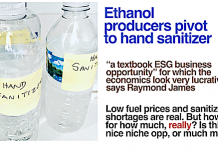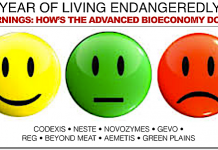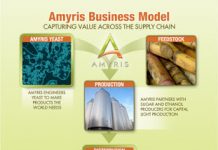Comet, BioAmber in big cellulosic sugar partnership
Jim Lane
In Ontario, Comet Biorefining has signed an off-take agreement with bio-succinic acid producer BioAmber (BIOA) for cellulosic dextrose from Comet’s upcoming first commercial plant in Sarnia, Ontario. The dextrose will be produced from agricultural residues using Comet’s innovative technology.
The agreement also provides increasing shape to the development of an biobased industrial cluster in the Sarnia region of Ontario a corn-growing region where farmers will provide agricultural residues which will be processed into industrial-grade cellulosic dextrose by Comet. In turn, BioAmber will be the offtake partner for those sugars, and use its own proprietary technology to produce biobased succinic acid and high-value derivative chemicals including 1,4-butanediol (BDO) and tetrahydrofuran (THF).
The off-take agreement also includes provisions for Comet to supply dextrose to future BioAmber manufacturing facilities and provides BioAmber with certain exclusive rights in the fields of succinic acid, BDO and THF. BioAmber itself is the subject of an historic set of off-take agreements, including those with Mitsui and Vinmar for global distribution of its renewable chemicals.
The partners also noted that Comet’s facilities can be built on a smaller scale enabling greater flexibility to locate production closer to biomass supplies and lower a region’s greenhouse gas footprint.
BioAmber investing in Comet
The companies disclosed that BioAmber had provided an equity investment in Comet in 2015 and its CEO Jean-Francois Huc is now joining Comet’s board of directors.
Where’s the feedstock?
The off-take agreement is the culmination of development work performed by Comet and BioAmber as part of BioIndustrial Innovation Canada’s recently completed cellulosic sugar study.
The one remaining question in the supply chain from cornfield to customer is how the supply-chain will be managed to assemble agricultural residues for Comet’s process.
Questions abound.
How these will be shipped, stored, avoid pre-fermentation or fire incidents that have been experienced at other cellulosic depots. How the payments will be made to growers, how the logistics of delivery will be arranged. How indeed the residues will be cleaned of dirt, dust, tennis shoes, rakes, combine harvester parts, metal scrap and other items that have come into cellulosic refineries from the field. Whether the bales will be square or round, how they will be tied and untied, where they will be stored from harvest to delivery to the factory gate.
How will the material be pre-treated at scale, how will it be chopped down into fragments small enough for the process to handle, at a rate and cost commensurate with the economics of the overall project?
How the greenhouse gas emissions will be calculated and audited, and how the process will be certified for sustainability for those chemical off-takers of BioAmber’s interested in certifying to their own customers that these new materials are contributing to a low-carbon society, and by how much?
All examples of standard questions that companies must answer, for themselves or in partnership with logistics companies. It’s not the same as the corn or cane economy not by the longest shot, and though Comet has doubtless with its partners in Sarnia and in the BioIndustrial Innovation Canada roundtables worked much of this out, we’ll all be awaiting more detail.
Front-end troubles have plagued the commissioning cycles of several cellulosic biorefineries though they are not only making sugars but fermenting them into ethanol. So, these questions although doubtless well advanced in terms of answers are relevant and pertinent.
We expect that some of them may be answered as soon as the first week of June, when Comet Biorefining chairman Andrew Richard addresses ABLC Feedstocks 2016. Additionally, Sandy Marshall, board chairman of Bioindustrial Innovation Canada, will make an address.
Marshall will be presenting on two studies. The first: setting up the corn stover value chain from the farm to the mill for the Comet project in Sarnia. Cost, quality, storing, delivery, and more. The second: on establishing a farm Coop, the Cellulosic Sugar Producers Co-op. Sandy worked closely with the BIC team on completing these studies and has been involved in numerous farmer meetings as well.
Reaction from the principals
Andrew Richard, Chairman and Founder of Comet Biorefining, said, “Having off-take agreements in place with bioeconomy leaders like BioAmber demonstrates the market’s confidence in our technology and products. As a trusted feedstock partner, Comet is helping to build a successful bioeconomy hub in Sarnia, Ontario, close to plentiful biomass. We are extremely pleased to welcome Jean-Francois Huc as a member of our board.”
Jean-Francois Huc, BioAmber CEO commented, “We have tested many second generation sugars and Comet offers dextrose that is on par with dextrose from corn, both in terms of quality and price. Comet has proven this by operating a large demonstration plant in Italy, setting them apart from others. Comet has also put together a unique value chain in Southwestern Ontario, bringing together farmers, technology, off-takers and government. We are looking forward to participating in their exciting growth prospects.”
The Comet backstory
Comet to build 30K ton biomass sugar plant in Ontario
Comet Biorefining hires Rich Troyer, formerly of Coskata, as CEO
The BioAmber backstory
Mitsui invests $25M in BioAmber JV; raises stake, will “play a stronger role”
Renewable chemicals, disruptive cost: The Digest’s 2016 8-Slide Guide to BioAmber
BioAmber: Biofuels Digest’s 2015 5-Minute Guide
Jim Lane is editor and publisher of Biofuels Digest where this article was originally published. Biofuels Digest is the most widely read Biofuels daily read by 14,000+ organizations. Subscribe here.








